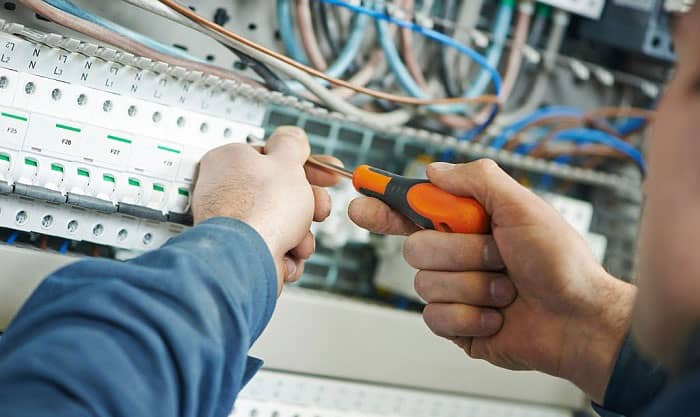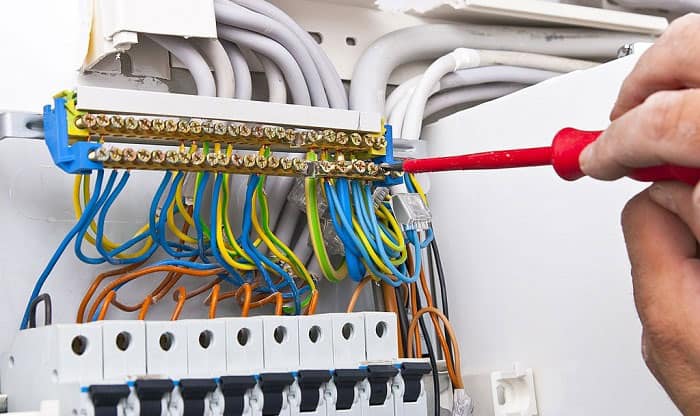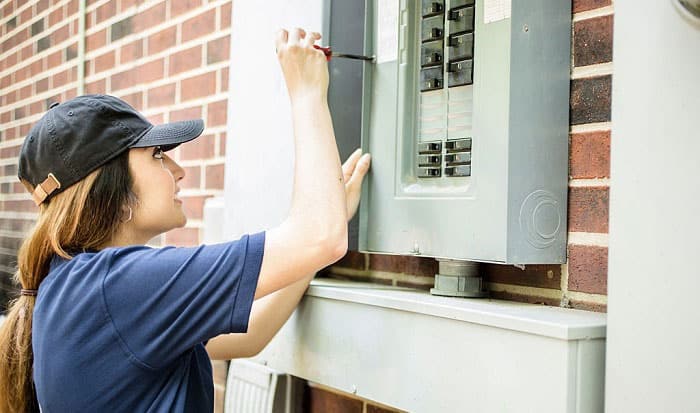Circuit Breaker Screwed on Circuit Breaker With Screw Fixed Funny

I've outlined how to replace a circuit breaker in this post. Circuit breaker replacement tends to be confusing. But rest assured that once you get all the necessary information you need, you'll find the job quite easy.
We're not doing this with a live circuit, so if that's what you're hoping for, sorry. We're doing this the good old standard, completely safe, and practical way. This includes killing the power first, removing the panel's cover plate, removing the wires from the original breaker, proceeding with the new circuit breaker installation, reattaching the wires, replacing the cover plate, and finally, restoring power. Go over this guide to understand the whole procedure.
Table of Contents
- Tools to Prepare Before Starting
- Step-by-Step Guide on Replacing a Circuit Breaker
- Step 1. Turn off the main power supplying the circuits and breaker.
- Step 2. Unscrew all the screws on the panel's cover using the appropriate screwdriver.
- Step 3. Be mindful of live parts before marking the original breaker with painter's tape.
- Step 4. Unscrew the screw on the original breaker then pull it slightly to take it off.
- Step 5. Install the replacement breaker.
- Step 6. Attach the corresponding wire to it.
- Step 7. Put the cover plate back in.
- Step 8. Flip the main breaker's switch back on to restore power.
- Conclusion
Tools to Prepare Before Starting

When replacing a breaker, the first thing you have to ensure is that you have the appropriate breaker replacement. Stick to the same manufacturer as much as possible. To be safe, refer to the same identification number on the label attached or printed on the breaker you intend to replace.
It's better if you can take a picture of the breaker, particularly the portion with the exact part number. Don't rely solely on visual matches when finding a circuit breaker because, in the end, it's the number that guarantees the compatibility of the breaker to the panel.
If you want a quick guide on how to find the proper circuit breaker replacement, I suggest you take the time to watch this video first:
Other than the replacement breaker, you'll need other tools for protection, opening the panel, and adhesion like:
- Screwdriver (Most breakers may require a flat-head one)
- Painter's tape
- Flashlight (You'll likely be plunged in darkness once you kill the main power supply)
- PPE like safety glasses and insulated gloves (If you want to be extra careful)
- Multimeter or voltage detection pens (Optional if you want to check for live wires)
This method of replacing the breaker switch is the only one I've followed through the years because it's solid, smooth, and safe. It works well even if you have to deal with a blown circuit breaker or one that has stopped tripping altogether. The same goes for those who only want to replace a breaker because they want to update it with one that meets UL standards or the NEC.
Step-by-Step Guide on Replacing a Circuit Breaker

Got the proper replacement breaker? Yes? Then, let's start replacing the one on your panel! Incidentally, did you notice a line of grease on the bottom part of the breaker? Do not wipe it off because it's deliberately placed there to help it slide smoothly into the busbar!
I'm assuming that you already know where the panel is located, so we're going to start with shutting off the main power first. Now's the best time to wear any protective equipment you have on hand.
Step 1. Turn off the main power supplying the circuits and breaker.
Again, we're choosing the safest route when changing a circuit breaker, so this will always be the first step that you need to do. Find your home's primary circuit breaker and simply switch it to the 'Off' position. This should effectively shut down the panel and all the circuits connected to it.
I suggest you do what most professional electricians practice when shutting down the breaker: Stand to its side because there's always a very small chance that it might cause sparks or even a tiny explosion that may harm you.
NOTE: This underlines the importance of wearing safety glasses when handling the main circuit breaker. You should consider putting on the gloves because you didn't exactly turn off your home's whole electrical service. The lugs connected to the breakers may still electrocute you because they're fed with electricity.
Step 2. Unscrew all the screws on the panel's cover using the appropriate screwdriver.
With the main breaker now shut off, it's time to work on removing the panel's cover plate. Many beginners make common mistakes when removing, so pay attention to my tip.
Most plates can be surprisingly hefty, so chances are, they won't be able to stay in place as you remove each screw. This is why I advise you to support or hold the plate with something as you remove it, assuming you can't manage its weight on your own. It's better if you have an assistant.
This is important because you don't want the plate to come in contact with the panel's contents as you're removing it. Take it off nice and slow.
Step 3. Be mindful of live parts before marking the original breaker with painter's tape.
With the plate taken off, you can now start removing the breaker. For safety's sake, take the time to verify the portions of the panel that may still carry the risk of electrocuting or shocking you. You may use a voltage detection pen or multimeter to do this.
Always remember this: anything that is above the main breaker should be considered as still carrying dangerous voltage. Now that that's taken care of, you may start removing the original breaker. To efficiently remove a circuit breaker, I mark it with painter's tape, so I won't end up confusing it with the new one I bought.
Step 4. Unscrew the screw on the original breaker then pull it slightly to take it off.
Done marking the breaker? Now, it's time to remove it. Almost all breakers contain a single screw on their ends or edges. You simply have to loosen the screw a bit, and this should disengage the wire. With that done, you shouldn't have to struggle too much in pulling the breaker off the busbar by prying its edge with your fingers.
One thing I do whenever I change a circuit breaker and have to take the original one off is to use one hand for pulling and the other for pushing its sides once I've dislodged it a bit. Trust me, this will save you time and effort pulling it off.
Step 5. Install the replacement breaker.
Got the old breaker off? Good! Let's now replace the breaker in the panel. If you're thinking of just pushing it in, don't even try! You'll only waste your time. Some homeowners even think they bought the wrong breaker if it's not sliding in. I assure you that that's not the case.
Most breakers are actually designed to be installed at a specific angle. They have built-in hooks that should latch onto the busbar. Once you're sure that it's engaged, you should push it in.
Step 6. Attach the corresponding wire to it.
With the new breaker properly in place, you have to make sure that the original wire is also correctly connected to it. Do you see the screw on the new breaker? You'll have to loosen that a bit, so you can attach the wire to it.
Please remember that you should NOT place the wire below the loosened screw. Rather, it should be sandwiched between the two plates directly underneath the built-in screw. You can set it in place by tightening the screw with your screwdriver. You may have to hold the wire as you're tightening it because you might end up with loose connection issues before long. Aim for a snug fit!
Step 7. Put the cover plate back in.
You're technically done with the replacement process from this point on. You just have to replace the panel cover. Some people have issues putting the plate back because of the weight or because it won't set properly.
My advice is to make sure that everything locks in position. You may need to shake the cover a bit to get it to fit as it should. Don't attempt to screw it back in place if you know that the plate might fail to protect the panel's contents over time.
Step 8. Flip the main breaker's switch back on to restore power.
You only need to slide its switch to the 'On' position. You might meet some resistance when pulling the switch. If you do, one nifty trick I do is position my hands in such a way that I can use my two thumbs to push it. It snaps into the right position every time!
Congratulations! You've just replaced a breaker in your home!
Conclusion
Did you enjoy this guide on how to replace a circuit breaker? Again, this is the only method I follow because it's 100% safe and is backed by professional electricians. It's also considerably beginner-friendly and will help you save a couple of bucks in electrician fees.
Do you agree with the guide and most of the tips I shared? Please don't be shy in sharing your thoughts in the comments section below. I'll be grateful if you took the time to share it too!

I am Edwin Jones, in charge of designing content for Galvinpower. I aspire to use my experiences in marketing to create reliable and necessary information to help our readers. It has been fun to work with Andrew and apply his incredible knowledge to our content.
Source: https://www.galvinpower.org/replace-a-circuit-breaker/
0 Response to "Circuit Breaker Screwed on Circuit Breaker With Screw Fixed Funny"
Post a Comment